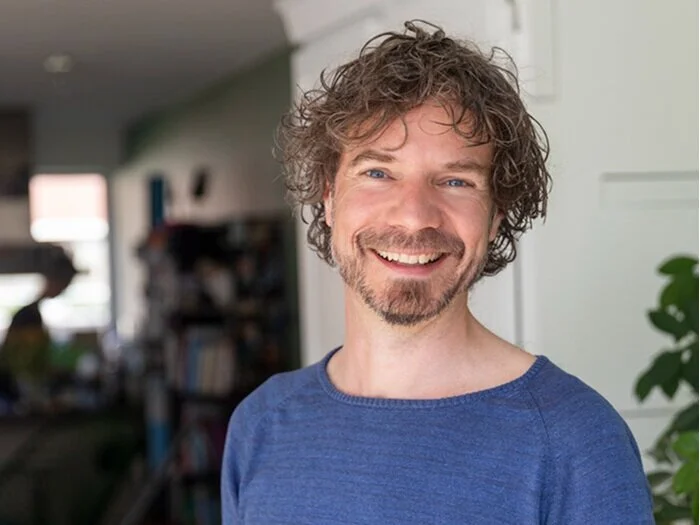Smart design lasts many lifetimes
Aernout Dijkstra-Hellinga - Lead Designer & Sustainability Expert
At Bugaboo, they understand that product sustainability begins with smart designs. Pushchairs are often passed from family to family. The longer they remain in use, the more circular they become. So Lead Designer Aernout Dijkstra-Hellinga doesn’t just consider the environmental impact of the materials and the production process, he also ensures that his pushchair designs can last many lifetimes with only a few minor adjustments
How do you apply circularity to your designs?
We design durable, multifunctional products that are easy to repair: for example, a seat that can be used standalone or on an infant pushchair or a frame that can serve as both a cradle and a seat. We’re aware that certain parts will undergo greater wear and tear, so they have to be easy to replace. Moreover, our pushchairs are easy to adapt to the user’s taste. Whether it’s their first purchase or their next: a different colour and material for the handles or wheel covers will give the pram a new look, making it attractive over a longer period and reducing the overall number of pushchairs produced.
Which design principles do you employ, and how do you arrive at this decision?
Where possible, our designs feature click and screw connections, and we avoid the inseparable bonding of different materials, such as two-component injection moulding or sealing parts together. Using these screws really simplifies the product maintenance for the retailer and the user.
Parts that mainly determine the appearance and style, such as wheel covers and upholstery, must have a lower environmental impact than those that have an ‘infinite’ life span. We try to avoid new materials, opting instead for materials that can be reused. That’s why we try to clearly indicate on each part what it’s made of. We avoid using black plastic for the parts that are not as visible so they are easier to recycle. Our next step will be to reduce the number of different types of plastics we’re allowed to use as the designers and engineers at Bugaboo: larger volumes per plastic type will result in cheaper purchasing and also facilitate more recycling. Having fewer types of plastic in greater volumes makes it easier and more financially attractive to separate them for recycling.
Examples are choosing polypropylene instead of polyamide. Applying the right finish to the structure creates outstanding quality and saves no less than 60% on the environmental impact because it requires less energy to produce. What’s more, it’s easier to recycle.
For our latest pushchair’s product packaging, we’ve replaced all the foam and loose plastic bags with cardboard and a single plastic bag in which all the textiles are packed. The next step will be to analyse the inks we use, so we can replace those that are oil-based. This is better for the environment and, in the near future, it will also be compulsory in countries such as France, for example.
How do you calculate the environmental impact of your products and parts? And do you let that inform your decisions?
““Review the entire life
cycle, see the possibilities,
make your decision and then
onboard your colleagues.””
With the help of the Eco Costs Value database from the Delft University of Technology and the Ansys Granta database, I perform a life-cycle analysis (LCA) that I then use to calculate a product’s CO2 emissions. For the time being, these are only approximate assumptions that do not include such things as the emissions from transporting the product to the customer. Our Bugaboo Donkey emits approximately 140 kilograms of CO2. Giving pushchairs a second life with new fabric rather than buying a new one prevents 100 kilograms of CO2 emissions.
In my designs, I do take the lowest possible CO2 emissions into account, but this is not yet a set target. However, we’re currently collaborating with the company Science Based Targets to develop more numerical targets that businesses can use to help guide their decision-making.
How do you persuade your colleagues to opt for circular solutions that may be more expensive or possibly less attractive? What is the role of the circular designer?
The designer plays a decisive role. After all, he or she determines the design of the product, including the choice of materials etc., that meets the various requirements of the stakeholders. And a designer is trained to skilfully see and think of opportunities that no one else identifies and to integrate colleagues into his or her vision of the future.
I try to get colleagues on board by combining various advantages. For example, apart from the environmental aspects, screw and click connections allow us to produce a special product version in a special colour.
In the future, designers will have to be even less product-oriented, needing to consider the convenience, experience and solution they can offer users. That can be done just as well, if not better, with a service rather than a product. The designer must develop a holistic vision that encompasses the entire life cycle of the product or service: from the extraction of the raw material, and the conditions under which this occurs, to what happens with the materials once their (extended) lifespan has ended. And they must then convey that story to purchasing, management, marketing and sales, and convince and motivate them.
““We’re trained better than anyone to spot and think
of opportunities that no one else identifies.””
What sort of challenges do you and your colleagues face in circular design?
Together with technicians, buyers, legal experts and marketers, we determine the functionalities and the look and feel of the product. Then we design a pushchair that complies with the technical requirements and rules and regulations. When choosing materials, I also have to work with the purchasing department and the suppliers. They indicate the possibilities regarding which new, circular materials we can use and which we cannot. In practice, I’d like to use even more recycled consumer plastic, but this isn’t always possible. Due to its unknown composition, this plastic’s quality can vary, and it sometimes contains chemicals that make it unsuitable for all the parts of a pushchair. In consultation with colleagues and the supplier, we then investigate in which parts of the product this type of plastic can be used.
Our Compliance Department also looks at rules and regulations and risk mitigation, which sometimes has a direct consequence for a design. One of our pushchairs had a removable canopy above the suspension that was designed to snap off. This presented a risk for which the legal expert offered the solution of an extra canopy. However, that creates an even bigger environmental impact. As designers, we developed a new design that minimised the risk and reduced the additional environmental impact.
Bugaboo has tried to lease pushchairs and even considered a refurbished line. Why did these ultimately not work out?
Our organisation was not designed to enter into longterm financial relationships with multiple individual clients. One example involved arranging monthly payments. Now, we would make the decision to engage a service organisation to handle this.
Taking back and exchanging pushchairs and dispatching and receiving accessories or parts presents a major logistics challenge. And it is a challenge that is not constant but is unpredictable. Moreover, inspecting the pushchairs, replacing parts and storing and identifying which parts (new, old, how often used) are still in which pushchair is both labour- and administration-intensive. That’s an expensive proposition given the current tax on labour rather than on raw materials and capital.
I was also unpleasantly surprised by the users’ rough handling of the pushchairs, despite the high deposit. That’s why I’m not entirely convinced that such a business model necessarily offers environmental benefits for a product like a pushchair. It probably works better with more robust products, highly expensive appliances or services such as washing or lighting. A business-to-business market might be more suitable for pushchairs.
Do you have any advice for other designers?
Processes of this kind take time, and you’ll face resistance to change. Stay optimistic and don’t lose sight of the bigger picture. Make sure that every step, no matter how small, is heading in the right direction.
Seek out inspiration from other companies and designers. I always find the information presented on the Ellen MacArthur Foundation website to be very clear and inspiring. Their ‘learning hub’ contains all kinds of tools to apply circularity in your organisation and in various sectors. And remember to work together. You may want to solve everything on your own, but it’s too difficult. A handy app that will give you a feel for the environmental impact of materials is IdematLightLCA. This app helps you quickly find more information about materials, eco-costs and CO2 consumption, and enables you to visually compare different materials.
Never focus on sustainability alone. For many people, customers and users, this is not a decisive reason to purchase or use the product or service. It’s more about the bigger picture, and sustainability and circularity form a vital part of this.












